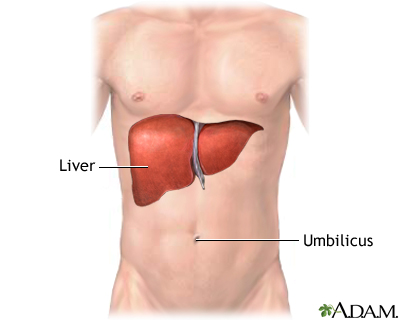Health Library
Nonalcoholic fatty liver disease
Fatty liver; Steatosis; Nonalcoholic steatohepatitis; NASH
Nonalcoholic fatty liver disease (NAFLD) is the buildup of fat in the liver that is NOT caused by drinking too much alcohol. People who have it do not have a history of heavy drinking. NAFLD is usually but not always related to being overweight.
For many people, NAFLD causes no symptoms or problems. A more severe form of the disease is called non-alcoholic steatohepatitis (NASH). NASH can cause cirrhosis and liver failure. It can also cause liver cancer.
Images

I Would Like to Learn About:
Causes
NAFLD is the result of more than normal deposits of fat in the liver. Things that may put you at risk include any of the following:
- Being overweight or obese. The more overweight you are, the higher the risk.
- Prediabetes (insulin resistance).
- Type 2 diabetes.
- High cholesterol.
- High triglycerides.
- High blood pressure.
Other risk factors may include:
- Rapid weight loss and poor diet
- Gastric bypass surgery
- Bowel disease
- Certain medicines, such as calcium channel blockers and some cancer drugs
NAFLD also occurs in people who have no known risk factors.
Symptoms
People with NAFLD often have no symptoms. When symptoms occur, the most common include:
- Fatigue
- Pain in the upper right abdomen
In people with NASH who have liver damage (cirrhosis), symptoms may include:
- Weakness
- Loss of appetite
- Nausea
- Yellow skin and eyes (jaundice)
- Itching
- Fluid buildup and swelling in the legs and abdomen
- Mental confusion
- GI bleeding
Exams and Tests
NAFLD is often found during routine blood tests that are used to see how well the liver is working.
You may have the following tests to measure liver function:
- Complete blood count
- Prothrombin time
- Blood albumin level
- Serum transaminases
Your health care provider may order certain imaging tests, including:
A liver biopsy is needed to confirm a diagnosis of NASH, the more severe form of NAFLD.
Treatment
There is no specific treatment for NAFLD. The goal is to manage your risk factors and any health conditions.
Your provider will help you understand your condition and the healthy choices that can help you take care of your liver. These may include:
- Losing weight if you are overweight.
- Eating a healthy diet that is low in salt.
- Not drinking alcohol.
- Staying physically active.
- Managing health conditions such as diabetes and high blood pressure.
- Getting vaccinated for diseases such as hepatitis A and hepatitis B.
- Lowering your cholesterol and triglyceride levels.
- Taking medicines as directed. Talk to your provider about all medicines you take, including herbs and supplements and over-the-counter medicines.
Losing weight and managing diabetes can slow or sometimes reverse the deposit of fat in the liver.
Outlook (Prognosis)
Many people with NAFLD have no health problems and do not go on to develop NASH. Losing weight and making healthy lifestyle choices can help prevent more serious problems.
It is unclear why some people develop NASH. NASH can lead to cirrhosis.
When to Contact a Medical Professional
Most people with NAFLD do not know they have it. See your provider if you begin to have unusual symptoms such as fatigue or abdominal pain.
Prevention
To help prevent NAFLD:
- Maintain a healthy weight.
- Eat a healthy diet.
- Exercise regularly.
- Limit alcohol consumption.
- Use medicines properly.
References
Chalasani N, Younossi Z, Lavine JE, et al. The diagnosis and management of nonalcoholic fatty liver disease: practice guidance from the American Association for the study of liver disease. Hepatology. 2018;67(1):328-357. PMID: 28714183 pubmed.ncbi.nlm.nih.gov/28714183/.
National Institute of Diabetes and Digestive and Kidney Diseases website. Eating, diet, and nutrition for NAFLD and NASH. www.niddk.nih.gov/health-information/liver-disease/nafld-nash/eating-diet-nutrition. Updated April 2021. Accessed August 11, 2021.
Torres DM, Harrison SA. Nonalcoholic fatty liver disease. In: Feldman M, Friedman LS, Brandt LJ, eds. Sleisenger and Fordtran's Gastrointestinal and Liver Disease: Pathophysiology/Diagnosis/Management. 11th ed. Philadelphia, PA: Elsevier; 2021:chap 87.
BACK TO TOPReview Date: 4/22/2021
Reviewed By: Michael M. Phillips, MD, Emeritus Professor of Medicine, The George Washington University School of Medicine, Washington, DC. Also reviewed by David Zieve, MD, MHA, Medical Director, Brenda Conaway, Editorial Director, and the A.D.A.M. Editorial team.
 | A.D.A.M., Inc. is accredited by URAC, for Health Content Provider (www.urac.org). URAC's accreditation program is an independent audit to verify that A.D.A.M. follows rigorous standards of quality and accountability. A.D.A.M. is among the first to achieve this important distinction for online health information and services. Learn more about A.D.A.M.'s editorial policy, editorial process and privacy policy. A.D.A.M. is also a founding member of Hi-Ethics. This site complies with the HONcode standard for trustworthy health information: verify here. |
The information provided herein should not be used during any medical emergency or for the diagnosis or treatment of any medical condition. A licensed medical professional should be consulted for diagnosis and treatment of any and all medical conditions. Links to other sites are provided for information only -- they do not constitute endorsements of those other sites. © 1997- 2021 A.D.A.M., a business unit of Ebix, Inc. Any duplication or distribution of the information contained herein is strictly prohibited.
